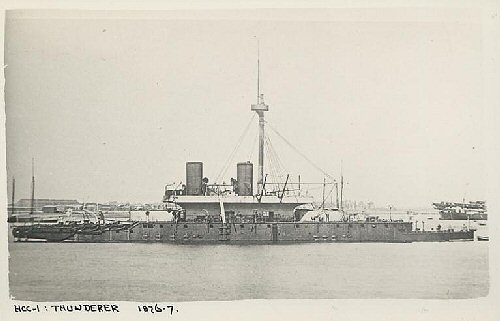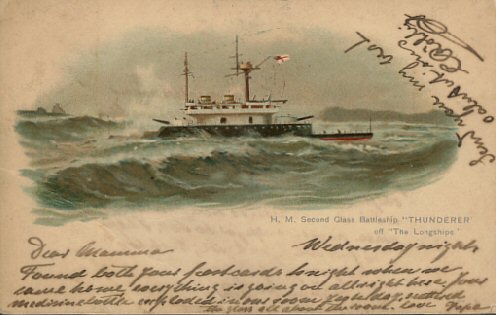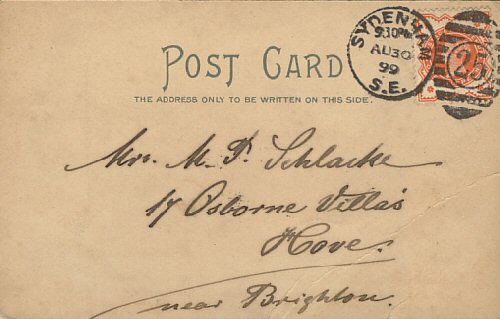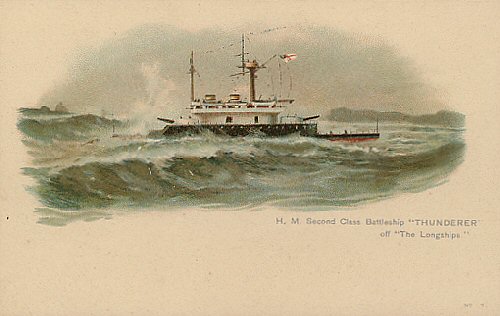
Sold for Scrap 1909
HMS Thunderer was the first ship whose forward turret had hydraulic loading gear. Her completion was delayed by a boiler explosion in July 1876, and a second accident occurred when one of her 38t guns burst after being double loaded. She was refitted in 1881, and modernised in 1890 - 92.
Armament: four 29 ton guns, six 6 pounder guns and eight 3 pounder quick firers with a partial belt of armour from 12ins to10 ins. Displacement: 9,330 tons. I.H.P: 7,000. Length: 285 ft. Beam: 62ft 3 ins. Max Draught: 27ft 6ins. Speed: 14 knots (after modernisation). Complement: 410.
The Thunderer was an iron second-class battleship, completed for sea in 1877. She was built at Pembroke Dockyard, and engined by Messrs Maudsley, Son & Field. Her displacement was 9,330 tons; IHP 7,000, Length 285 ft. Beam 62 ft 3 ins. Maximum draught 27ft. She carried as her principal armament, four 10 in 29 ton guns; and six 6 pounder guns and eight 3 pounder quick-firers, and had a partial belt of armour from 12 to 10 ins. Her speed was 14 knots and complement of 410. In May 1895 the Thunderer was sent to Milford Haven as guardship and in 1896 she carried the pennant of Captain H W S Gibson.
"The most disastrous accidental boiler explosion in the annals of the Royal Navy occurred in the battleship Thunderer on 14 July 1876, and it led to the death of more than 40 persons. The Thunderer, the sister of the turret ship Devastation, had been supplied with eight rectangular box boilers, arranged in two stokeholds, constructed by Humphrys, Tennant and Company for a working pressure of 30 lb. per square inch. On the day of the accident, the ship proceeded out of Portsmouth Harbour to Stokes Bay to carry out a full-power trial. Many officials were on board to watch the trials, and the ship was just being put on her course, when without any warning, the upper part of the front of the starboard forward boiler was blown out and the stokeholds and engine rooms were immediately filled with the release of steam. The explosion killed fifteen men instantly, including her commanding officer, who was in the engine room at the time, and seriously wounded seventy others, thirty of whom subsequently died of their injuries. Owing to the extraordinary nature of the explosion, the inquiry that followed was very thorough, and many eminent engineers gave evidence. The reasons for the explosion, however, were not far to seek, and they had nothing to do with construction or condition of the boilers. It was show conclusively that no one had opened the stop valves, and that the pressure gauge, having been found out of order, had been shut off, while examination and experiments with the safety valves in the shop left no doubt that they had become inoperative having seized in their seats through corrosion. The safety valves were of the dead-weight type, and while the valves and seatings were of brass, the safety-valve box was a large iron casting. Had the stop valves been open, or the safety valves been in working order, the accident could not have occurred, while if the pressure gauge had been in use, attention doubtless would have been called to the undue rise in pressure. As it was, no one could say at what pressure the boiler gave way. For the inquiry, a model of the boiler as it appeared after the accident was made in Portsmouth Dockyard, and this is now preserved in the Science Museum, London.
The Thunderer, which was launched in 1872 and completed in 1876, was the last capital ship in the Navy to have rectangular boilers. Whilst such boilers had proved satisfactory for steam pressures up to 30 lb. per square inch cylindrical boilers were required for higher pressures required for higher powers. There had been some reluctance to adopt higher steam pressures for fears of the consequences of an accident but, since this explosion showed that even low pressure steam could be lethal, it seems to have been argued that high pressure steam would be no worse. The accident also brought about the introduction of the spring-loaded safety valve, with an alarm whistle fitted which blew when the pressure reached a few lb. per square inch above the set pressure of the main valve; it was also arranged that safety valve easing gear could be worked from the deck above the boilers.
In 1879 the Admiralty issued the Steam Manual for Her Majesty's Fleet; containing Regulations and Instructions relating to the Machinery of Her Majesty's Ships."


